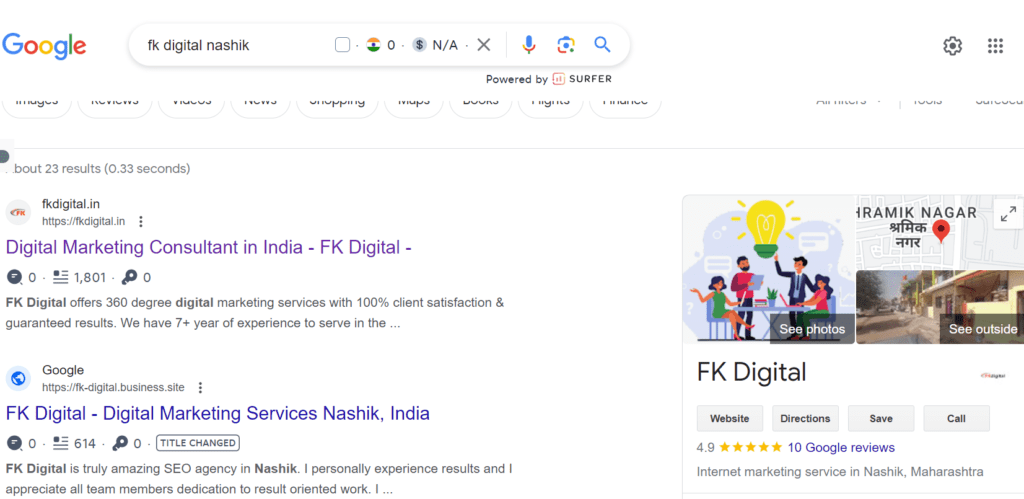Introduction
Local search is effective for small businesses. 46% of all Google queries are for local information. You can lose out on potential clients who are prepared to shop in your neighborhood if your company isn’t optimized for local search. Simply said, if you want your company to remain relevant, local SEO is essential.
We’ve developed a thorough guide covering local SEO techniques and tools to assist you in optimizing your business for local SEO.
“By the end of the guide, you’ll have a firm understanding of how to optimize your business to reach potential consumers who use local search to decide which products or services they’re going to buy,” says the author.
Also, Read: Technical SEO Audit Checklist
What is Local SEO?
Local SEO, short for Local (Search Engine Optimization), is a digital marketing strategy focused on optimizing a business’s online presence to attract more local customers.
It involves various techniques to improve the visibility of a business on local search engine results, online directories, and map services. Local SEO is particularly essential for businesses with physical locations, like dental practices, restaurants, retail stores, and other local service providers.
Benefits of Local SEO
Increased Local Visibility: Local SEO techniques help your dental practice appear prominently in local search results when potential patients search for services in your area. This increased visibility can lead to more website traffic, phone calls, and walk-in visits to your clinic.
Targeted Traffic: Local SEO targets users who are actively looking for dental services in your locality. By optimizing for location-specific keywords, your practice can attract highly targeted traffic that is more likely to convert into actual patients.
Google My Business (GMB) Optimization: Local SEO includes optimizing your Google My Business listing, which is crucial for local searches. An optimized GMB profile provides essential information about your dental practice, such as address, phone number, business hours, and customer reviews.
Positive Online Reviews: Local SEO strategies encourage patients to leave positive reviews on platforms like Google, Yelp, and Facebook. Positive reviews not only influence potential patients’ decisions but also contribute to higher rankings in local search results.
Mobile-Friendly Experience: Local searches are often conducted on mobile devices. Local SEO ensures that your website is mobile-friendly, enabling potential patients to access essential information easily and make appointments conveniently.
Beat Local Competition: Local SEO allows your dental practice to stand out from local competitors. With effective optimization, you can surpass other practices in local search rankings, attracting more patients and building a strong local presence.
Cost-Effectiveness: Compared to traditional advertising methods, local SEO offers a cost-effective approach to reach a highly targeted audience. It allows you to allocate your marketing budget more efficiently by focusing on potential patients in your area.
Increased Trust and Credibility: A well-optimized local online presence, with positive reviews and accurate business information, builds trust and credibility among potential patients. This trustworthiness can lead to higher patient retention and word-of-mouth referrals.
Here’s a step-by-step Guide on how to Improve Local SEO
Step 1: Claim and Optimize Your Google My Business Listing

Claim your Google My Business (GMB) listing and ensure that all your practice information is accurate and up to date.
Provide complete details, including your practice name, address, phone number, website URL, and business hours.
Choose the most relevant categories for your Business.
Upload high-quality photos of your office, staff, and treatments.
Step 2: Encourage Reviews and Respond Promptly
Encourage your satisfied patients to leave positive reviews on your GMB listing.
Respond to reviews, both positive and negative, in a professional and timely manner.
Address any concerns or issues raised in negative reviews to demonstrate your commitment to patient satisfaction.
Step 3: Optimize Your Website for Local Keywords
Conduct keyword research to identify relevant local keywords for your Business.
Incorporate these keywords naturally into your website’s content, including headings, page titles, meta descriptions, and image alt tags.
Create location-specific landing pages to target different areas you serve.
Step 4: Build High-Quality Local Citations
Ensure your practice name, address, and phone number (NAP) are consistent across all online directories, including local directories, industry-specific directories, and social media profiles.
Aim for high-quality directories with strong domain authority.
Include complete and accurate information, and provide a link back to your website whenever possible.
Step 5: Implement Schema Markup
Add schema markup to your website’s HTML code to help search engines understand and display relevant information about your practice.
Include schema markup for your practice’s name, address, phone number, business hours, reviews, and other pertinent details.
Step 6: Optimize for Mobile
Ensure your website is mobile-friendly and responsive, as more people now use mobile devices for local searches.
Optimize page load speed to improve user experience and search engine rankings.
Step 7: Create Locally Relevant Content
Publish blog posts or articles that address common concerns or topics specific to your local area.
Share your business tips, community events, and news about your practice to engage with your local audience.
Step 8: Engage in Local Link Building
Seek local partnerships and collaborations with other businesses or organizations in your area.
Guest post on local blogs or contribute articles to local publications to build relevant backlinks to your website.
Step 9: Monitor and Analyze Your Local SEO Efforts
Use tools like Google Analytics and Google Search Console to monitor your website’s performance, including organic traffic, rankings, and conversions.
Regularly track your local SEO efforts and make necessary adjustments based on data and insights.
By following these steps, you can improve your business’s local SEO, increase your online visibility, attract more local patients, and ultimately grow your business.
Local SEO Tools
- Whitespark Local Citation Finder
- Screaming Frog
- Moz Local
- Ahrefs
- Buzzstream
- Bright Local
- SEMrush
Conclusion
In conclusion, local SEO is a powerful digital marketing strategy that can significantly impact the success of your business. By optimizing your online presence for local searches, you can attract more targeted patients, increase visibility, and ultimately grow your practice in the competitive local market.


Your article helped me a lot, is there any more related content? Thanks!
Thanks for sharing. I read many of your blog posts, cool, your blog is very good.